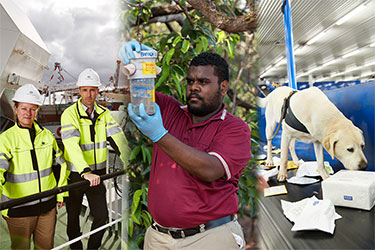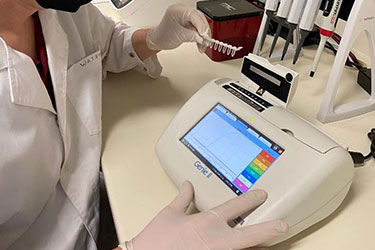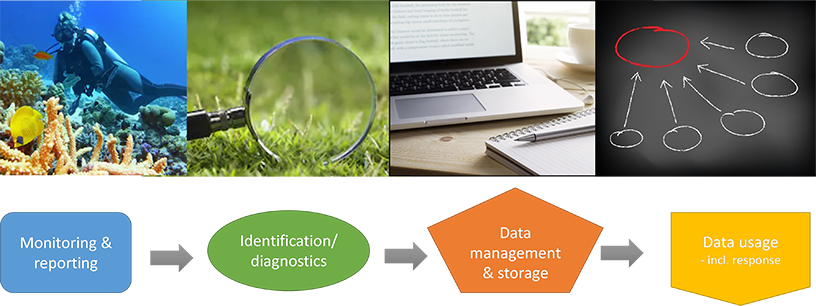Biosecurity is the management of the risk of pests and diseases entering, emerging, establishing or spreading in Australia and causing harm to animals, plants or human health, the economy, the environment and the community.
A huge return on investment to safeguard Australia’s agriculture and environment
Australia’s biosecurity system protects our agriculture and environment from harmful pests and diseases.
How do you put a value on Australia’s world-class biosecurity system?
We posed that challenge to the Centre of Excellence for Biosecurity Risk Analysis (CEBRA) at the University of Melbourne. To answer it, they developed a model to work out the value our biosecurity system brings to the country’s agriculture, environment and economy.
But first, what is our biosecurity system? In simplest terms, it’s the combination of all activities we undertake at our borders and around the country to protect our agriculture and environment from invasive pests and diseases. It’s activities to detect them before they enter our country, and response and recovery efforts if they do.
So, let’s talk about the numbers…
Continue reading about a huge return on investment to safeguard Australia’s agriculture and environment
Through modelling, CEBRA determined that the system will prevent $314 billion of damages net present value to our agriculture, environment and human amenities over the next 50 years. The combined value of the assets the system protects over that period is more than $5.7 trillion.
Cathryn Geiger, head of Biosecurity Risk and Innovation, said the model demonstrates why Australia invests in biosecurity.
‘The $314 billion of damages that will be avoided over the next half century shows why we invest in a good, strong system, and look for ways to stay ahead of the curve with innovative technology,’ Ms Geiger said.
‘We will see about a $30 return for every dollar invested by the Australian Government.’
The figures are initial results, and the model will be refined in future to provide the most accurate picture possible. It will help us fine tune our biosecurity activities so we get the best return on investment possible.
‘Our biosecurity system is world-class, and ever evolving,’ Ms Geiger said.
‘It makes our agricultural products among the best in the world, and keeps our rich environmental heritage safe. If the system were to stop, all of that would be at stake.’
Find out how CEBRA’s model works by reading their report.
Kicking up conditions to keep khapra out!
We are taking urgent actions to prevent this devastating plant pest from entering Australia.
Khapra beetle (Trogoderma granarium) is a small but serious agricultural pest! Second on our National Priority Plant Pest list and the number one plant priority pest for grains, the beetle poses a major biosecurity threat to Australia.
It’s a hardy and highly invasive pest that destroys grain quality, making it unfit for human or animal consumption.
While it can survive without food for extended periods, it will eat just about anything! It has been recorded infesting more than 100 commodities including most dried plant products such as grains, seeds, beans and nuts.
Australia is free of khapra beetle and it is important we keep it that way.
Continue reading about kicking up conditions to keep khapra out!
As interceptions of khapra beetle are increasing in imported plant products and as a hitchhiker in containers, we are ramping up import conditions to prevent its entry into Australia through a range of urgent actions.
The urgent actions are being introduced in phases. Phases 1 and 2 commenced in September and October, respectively, and introduced a ban on importing high-risk plant products via:
- unaccompanied personal effects
- low value sea and air freight
- international mail items
- international travellers entering via sea or air.
This means that these products can no longer be brought into Australia via the above pathways (some exclusions apply). Instead, importers are encouraged to buy these products from Australian suppliers who have either sourced their products locally or imported them through commercial channels.
In the next phase, the department will implement changes to the management of shipping containers. These changes aim to address the risk of khapra beetle hitchhiking in shipping containers and are expected to commence in early 2021.
The department is currently working through what the changes will involve. A range of measures are being considered, including possible treatment options.
In later phases, the department will focus on high-risk plant products imported via commercial pathways and other risk plant products imported via all import pathways. This will include requirements for relevant products to be treated, inspected, and certified prior to export to Australia.
These phases are expected to commence in 2021, following further engagement with affected stakeholders.
For further information on the urgent actions, visit awe.gov.au/khapra-urgent-actions.
To learn more about khapra beetle, see the Khapra beetle bulletin.
You can also learn how we are using cutting-edge eDNA technology to detect khapra beetle from traces in dirt and dust, in an article in our biosecurity innovation hub The Seed.
Leading the way with molecular diagnostics
Our entomologists use cutting edge tests such as Loop Mediated Isothermal Amplification (LAMP) to assess samples for biosecurity risks.
Identifying potential biosecurity risks quickly and accurately is essential to preventing pest and disease incursions that could damage Australia’s agriculture and environment.
Through trialling fast, accurate and innovative plant and animal pest and disease diagnostic technology, we will significantly boost our diagnostic capability.
Our Science and Surveillance Group (SSG) has recently deployed rapid diagnostic tests for the identification of several high-priority insect pests that can be both challenging and time-consuming to identify by traditional methods.
Loop Mediated Isothermal Amplification (LAMP) is a method that rapidly provides a positive or negative result for a target species, resulting in reduced time and increased diagnostic accuracy.
Continue reading about leading the way with molecular diagnostics
Most recently, the LAMP method has been used by SSG scientists to quickly assess samples collected as part of our rapid response to Khapra beetle detections in imported fridges in New South Wales and the Australian Capital Territory.
LAMP diagnostic tests have also been rolled out to diagnose exotic mosquitos and are routinely used to test imported cut flowers for leaf miners in the genus Liriomyza.
Brown marmorated stink bug (BMSB), Varroa mite and spotted-winged drosophila border tests are currently being considered for development.
Furthermore, molecular biologists from the SSG’s Northern Australia Quarantine Strategy have successfully diagnosed high-priority pests within 24 hours using MinION DNA sequencing technology. This is a scalable technology that enables direct, real-time analysis of long DNA or RNA fragments.
Head of the SSG, Wayne See Kee, explained how this technology will help with diagnosing pests.
‘This is a significant improvement to the SSG’s molecular capability. Once the MinION technique has been refined, high-priority target pests and diseases could be sequenced in-house, resulting in up to a 90% improvement in turn-around times,’ Mr See Kee said.
‘In continuing to trial and implement these emerging technologies across its national footprint, the SSG is able to provide quicker biosecurity risk mitigation decisions, resulting in better biosecurity outcomes for all stakeholders.
‘Our work to improve our diagnostic capability is vital for Australia’s agricultural competitiveness. Without these technological steps forward, we would see increasing costs to importers such as demurrage and storage fees, less effective responses to biosecurity incursions, and an inability to provide assurance around exotic detections.’
Operation Alpine feeds good news to Australia’s animal production sector
Making sure imported additives are free of animal contaminants is vital for the ongoing health of Australia’s livestock.
Each year, Australia imports approximately 30,000 metric tonnes of stockfeed additives such as amino acids and vitamins.
These additives bolster the productivity of our livestock industries, which in turn underpins Australia’s competitiveness in the global market for animal products.
Our export industries rely on imported additives being free of contaminants that may harm the health of livestock.
The additives predominately come from China, the US and Singapore, and are subject to the biosecurity and regulatory controls that all imports are, in order to protect the health of our agriculture and environment.
Continue reading about Operation Alpine feeds good news to Australia’s animal production sector
To determine the effectiveness of the controls in place for imported stockfeed additives, this year we held Operation Alpine.
Acting Head of Animal and Biological Imports, Stephen Malone, explained how Operation Alpine worked.
‘A total of 13 stockfeed additive consignments were selected across the trade, and tested for animal material contamination,’ Mr Malone said.
‘All samples returned negative results. These results are assuring and indicate that current import controls for this commodity are effective. We kept the Stockfeed Manufacturers Council of Australia closely informed on this operation.
‘Additionally, no abnormal transhipment behaviour was observed during the operation — for example, shipments being turned around on the water. This is good news and indicates that the manufacturers have confidence in the integrity of their products.’
Any positive results would be concerning, as stockfeeds are one way that exotic livestock diseases such as African swine fever and foot and mouth disease could reach Australian herds.
‘Operation Alpine proved that we are working well to protect our agricultural industries from diseases that could devastate livestock and seriously damage Australia’s economy,’ Mr Malone said.
‘However, our work is never done, and we will keep being vigilant into the future so that Australian farmers can be assured that their stockfeed is safe.’
Details of regulatory controls for stockfeed, including additives, can be found on BICON.
Investigating what makes general surveillance work
General surveillance requires a systems-thinking approach.
With biosecurity risks increasing and finite resources available to manage them, general surveillance is becoming an increasingly important part of Australia’s biosecurity surveillance.
We define general surveillance as people from all walks of life participating in gathering and reporting information about the presence of pests, weeds and diseases.
The Australian Bureau of Agricultural and Resource Economics and Sciences (ABARES) has been exploring general surveillance in its ongoing ‘Making general surveillance work’ project.
Peter Gooday, head of ABARES’ Farm Performance, Biosecurity and Information branch, explained how the project works.
Continue reading about investigating what makes general surveillance work
‘We are using a holistic, systems thinking approach to develop a set of guidelines for policy-makers and practitioners to support the design, planning, implementation, monitoring and evaluation of general surveillance programs,’ Mr Gooday said.
‘As general surveillance programs are greater than the sum of their parts, systems thinking brings a fresh perspective about what works and what does not work, for programs as a whole,’ he said.
The approach focuses on the system components that support general surveillance, and the interactions between them. Components include the different groups of people involved and their relationships; the ways information, knowledge and resources flow; the rules involved; and other key processes.
‘We are integrating lessons learned across different sectors, contexts and aspects of general surveillance initiatives,’ Mr Gooday said.
‘We have a literature review available on the project website, and have also undertaken a stocktake of general surveillance programs throughout Australia and New Zealand.
Let us know if we have overlooked any.
‘We are currently exploring 9 active case study programs from throughout Australia and New Zealand, with case study overviews available for each upon completion.’
You can sign up to be informed of program updates.
Khapra beetle – an international challenge
Khapra beetle is a serious risk to Australia’s agriculture.
Recently we joined international biosecurity agencies in an online information exchange to help combat the devastating pest, khapra beetle, Trogoderma granarium.
Khapra beetleis a serious risk to stored grains, rice, oilseeds and dried foodstuffs, and is Australia’s second most important plant pest of concern.
It can cause significant losses to products held in stores, such as grains, and cause contamination with larval hairs that can be a health risk.
Australia is currently free from khapra beetle. To keep it that way, we are implementing a series of enhanced phytosanitary measures on imported goods to maintain this freedom.
In 2020, khapra beetle has been detected at the Australian border more times than any year previously, leading to the introduction of phased urgent actions.
Continue reading about Khapra beetle – an international challenge
Peter Creaser, head of Plant Systems & Strategies, said that khapra is an issue warranting international cooperation.
‘The increase in detections is why it’s vital to engage and share information with our counterpart biosecurity agencies across the globe,’ Mr Creaser said.
In October we hosted a webinar with a number of biosecurity agencies from the Latin American region to exchange information on khapra beetle.
Latin America, like Australia, is free of khapra beetle, so all countries participating in the webinar were eager to share and learn from each other.
Participants included senior officials from Argentina, Chile, Colombia, Guatemala, Mexico, Ecuador, Peru, Uruguay and the Central American International Regional Organization of Agriculture Health (OIRSA).
‘We were interested to learn that other Latin American countries have intercepted khapra beetle arriving more frequently and on commodities they previously had no association with, or from countries not known to have khapra beetle,’ Mr Creaser said.
More than half of countries participating had reported detections of khapra beetle, including interceptions in shipments of used cars and chemicals such as potassium sulphate.
Participants shared information on border management, interceptions, treatment methods and surveillance measures.
The webinar provided an important opportunity to discuss the evolving challenges in managing this serious pest, as well as some of the initiatives and technology being used to meet the challenge.
‘Keeping this devastating pest out of Australia is a joint effort by governments and industry, so we ask that anyone who comes across the pest should See. Secure. Report by calling 1800 798 636,’ Mr Creaser said.
Find out more about khapra beetle and how to report it.
Using forensic chemistry to combat illegal wildlife trade
New research is helping determine how long illegal exotic pets like red-eared slider turtles have been on the loose in the wild.
In the last edition of Biosecurity Matters, we reported on a research project we are funding through the Centre for Invasive Species Solutions (CISS) at the University of Adelaide. This edition we profile another CISS research program with biosecurity connections.
With illegal wildlife trade a major concern in Australia, University of Adelaide researchers, supported through CISS, have validated a new technique which uses forensic chemistry to identify where an invasive pest found in the wild has come from.
Using the red-eared slider turtle (REST) as a model species, this unique research was recently published in the journal NeoBiota.
Andreas Glanznig, CEO of the Centre for Invasive Species Solutions, said that REST is an important model since it is listed as an Australian Government priority exotic environmental pest and has also been identified by the World Conservation Union as one of the top 100 global invasive pests.
Continue reading about using forensic chemistry to combat illegal wildlife trade
’More than 10 million RESTs are exported globally, including illegally to Australia, from their native range in the US, as they considered popular pets,’ Mr Glanznig said.
’Unfortunately, due to this illegal trade, increasing numbers are now being found in the wild around Australian cities. If left unmanaged they could wreak havoc on our native flora and fauna.’
Researcher Katherine Hill explained that the technique analyses the chemical composition inside a sample from an individual turtle’s shell.
‘As the turtle shell grows slowly, we can learn what these turtles were eating up to 12 months ago using our chemistry techniques,’ Ms Hill said.
‘For example, if analysis shows that a shell sample has higher nitrogen stable isotope ratio, we expect that turtle has been eating enriched protein like pet food and was likely in captivity.
‘This is important as it can determine the origins of turtles found in the wild and potentially how long they have been there, allowing biosecurity officers to determine the best course of future management action.’
This detection technique forms part of a suite of new detection tools CISS is developing to help future proof Australia’s biosecurity system.
‘This new forensic chemistry technique builds on the REST environmental DNA detection technology being developed by University of Canberra researchers, which could be used in addition to further identify the extent of a REST incursion, particularly in waterways where you are concerned there may be others,’ Mr Glanznig said.
‘This research all helps drive an innovation-centred transformation of Australia’s biosecurity system so that new and efficient technologies can be deployed to counteract the increasing biosecurity risks from growing trade.
‘Detecting and subsequently avoiding the next pest animal threat, is just as important as managing current ones, and our Centre is working on delivering these new technologies to ensure that exotic pets don’t become our next national pest.’
Ms Hill is now completing her PhD studies through the University of Adelaide with the support of the CISS and is expanding the use of this technology to use on other species, including native Australian parrots, and investigating if stable isotopes can track the spread of already established invasive species.
This research is part of a suite of projects within the CISS incursions program looking at new and novel exotic species detection techniques, funded by the Australian Government Department of Agriculture, Water and Environment.
View the research paper, or find out more about CISS’s incursion projects.
Australian Biosecurity on Facebook – the cute and the not-so-cute
Cute animals on social media? Who would have thought? Follow us for adorable detector dogs and much more.
Have you connected with us on Facebook? We have an Australian Biosecurity Facebook page where you can find the most important thing social media provides: cute animal photos!
Follow us there to see stories of Australians reunited with pets after their stay at the mandatory Post-Entry Quarantine (PEQ) facility, as well as updates about our adorable biosecurity detector dogs in training and at work.
You can also watch our brand new Christmas video starring one of our detector dogs, with inspiration from the holiday classic Love, Actually.
It’s not all cute stuff, however! You can also see the weird and gross things we’ve intercepted at our mail centres and elsewhere this year, such as a whole garden of illegally imported succulent plants sent from China, or some creepy crawlies found in a fridge.
Continue reading about Australian Biosecurity on Facebook – the cute and the not-so-cute
You can also read stories about this year’s Australian Biosecurity Award winners – the researchers, farmers and other biosecurity champions who are working hard to make sure Australia stays free of harmful pests and diseases.
If Facebook isn’t your thing, you can also check us out on other social media platforms. Our Twitter feeds (@DeptAgNews and @envirogov) and LinkedIn page share stories from all corners of our portfolio, including biosecurity, agriculture, water resources and the environment.
If you’re keen to find out about cutting-edge biosecurity innovations that are evolving how we detect and manage biosecurity threats, check out The Seed, our biosecurity innovation hub.
Also consider checking out our sister publications: Water Matters and Agricultural Trade Matters.
We look forward to sharing much more with you across all our social media and news channels in 2021.
Merry Christmas and a Happy New Year!
See the latest Import industry advice notices or Export industry and market access notices.








